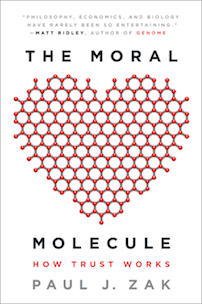By Anna Moyer
Nicknamed both “Dr. Love” and “the vampire economist,” it should come as no surprise that Paul Zak begins his tale at a picturesque wedding in Devon, England, where he is collecting hundreds of vials of blood from the wedding party. After all, the economist-turned-neuroscientist has in his career collected thousands of blood samples in search of a unifying approach to the brain chemistry behind pro-social behaviors. Zak posits that a single molecule, oxytocin, balances greed and generosity, aggression and compassion, and trust and wariness. Although this hormone is typically associated with reproduction and birth, Zak argues that oxytocin is the heart of the moral guidance system and the reason why blushing brides and grinning grooms trust one another reciprocally despite the risks of such vulnerability.
The Moral Molecule is a popular account of Zak’s decades of human research in oxytocin interwoven seamlessly with relevant experiments in psychology, economics, and animal behavior. Composed more like a series of charming anecdotes than a scientific report, it offers a general introduction to neuroeconomics, which is a new and interdisciplinary field that examines human decision-making. According to traditional economics models, each individual acts in a way that is rational and self-interested. However, when tested with an experimental research tool called the Trust Game, participants behave with more trustworthiness than these models would predict. Zak’s initial research with the Trust Game revealed that being trusted causes a spike in oxytocin levels that in turn prompts increased trust of others. This pay-it-forward “Virtuous Cycle” colors each concept explored in The Moral Molecule, which covers topics like the evolution of oxytocin, the subtleties of brain circuitry, how gender and abuse alter oxytocin levels, the formation of economic markets, and the importance of trust in democracy.
Zak’s propensity to describe the origins of both practical, real-life habits and more quirky behavioral curiosities makes reading The Moral Molecule engaging and relatable. From paternal attachment in prairie voles and lobster courtship rituals to why we appreciate great art, why testosterone levels drop after watching a favorite sports team lose on TV, and why hugging makes us more generous, Zak covers the biochemical bases underlying a great breadth of cultural and social behaviors. However, refreshingly, Zak does not reduce all of the complexity of human behaviors to a series of uninspiring chemical reactions. Instead, where it might be tempting to discount philosophical and theological discourse, Zak notes simply that “any discussion of free will seems a little pointless if it doesn’t take into account everything science can contribute.”
However, despite the scope of Zak’s oxytocin research, neuroeconomics is an emerging field and lacks a unified theory of decision-making. The final chapter of The Moral Molecule stresses that empathetic human connection, made possible by oxytocin, could lead to peace, happiness, and love, but it seems like an oversimplification to consider oxytocin a panacea for all evils. Particularly, Zak glosses over research indicating that oxytocin could be responsible for ethnocentrism and defensive aggression towards out-groups. As neuroeconomics develops and takes on additional nuances, oxytocin’s precise role in peace and morality should become clearer.
In the meantime, The Moral Molecule contains a variety of down-to-earth suggestions for how to improve trust and strengthen relationships. Zak is anything but pedantic as he presents sketches from his own life and inspires introspection and empathy by providing a new lens for considering morality. He proposes that enhancing communication, increasing positive exposure to diversity, implementing procedural fairness, and improving the quality of education are four basic ways to create a more prosperous and trusting society. More personally, and perhaps something we can all take to heart, Dr. Love recommends eight hugs a day to release oxytocin and kick-start the virtuous cycle from the bottom up.
Anna Moyer (ΦBK, University of Alabama, 2014) is in her last year of a dual Bachelor’s/Master’s program at the University of Alabama where she is majoring in biology and minoring in English. The University of Alabama is home to the Alpha of Alabama Chapter of Phi Beta Kappa.




